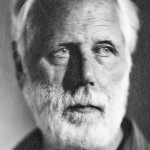
Peter Moseley
Centre for Fine Print Research
moseley@btinternet.com
http://www.uwe.ac.uk/sca/research/cfpr/research/traditionalprint/peter_moseley.html
Biography
Peter Moseley practices the photographic process of the late nineteenth and early twentieth century. Following retirement from a career in educational management, his long interest in photography was extended by a MA in Printmaking (Brighton). He is currently undertaking a PhD project at the Centre for Fine Print Research, UWE, investigating aspects of the image surface texturality and tonality of early photomechanical printing processes. Peter Moseley has had prints selected for exhibition at the Royal West of England Academy (2012) and the Royal Society of Printmakers Painters (2012) and two solo shows of portraiture – ‘Take Five’ (2005) and ‘Volte Face’ (2010).
Illustrated Talk
Manipulation of inkjet negative/positive transparencies to manage the image reflectance density, tonal gradation and contrast of photogravure, platinum, carbon transfer and other photographic contact printing processes.
Traditionally, positive transparencies for photogravure intaglio printing and negative transparencies for platinum and carbon-tissue transfer printing were produced from photographic film, providing continuous tone images of great detail, tonality and delicacy. Some of the finest photographic images in the late nineteenth and early twentieth century were printed using these processes and over the last decade an increasing number of artists have been attracted to the expressive possibilities of these techniques.
Choice of film stock for the production of the necessary transparencies has become much more limited over recent years and digitally produced negatives and positives from image-setters and ink-jet printers are increasingly favoured. The production of transparencies of a modest quality using ink-jet printers and commercially available acetate film is not difficult. However, comprehensive calibration routines are necessary if full control over tonal gradation and print contrast is to be secured, especially in the highlight and shadow areas. Each type of photosensitive coating/process responds differently to the type and spectrum emissions of ultra-violet lamp used for exposure and to the nature of the transparency substrate and the colour/composition of the ink-jet printer inks. The ink colour and UV absorbance of the negative transparency, or positive in the case of photogravure, can be varied to give enhanced control over reflectance density, tonal gradation and micro-contrast in the final print.
This illustrated talk will compare different techniques for the production of and calibration of ink-jet transparencies and the requirements for control of tonal gradation and contrast in respect of platinum, photogravure, carbon transfer and other photographic contact printing processes. The talk is complemented by a conference exhibition of some of Peter Moseley’s photogravure portraits.
Exhibition
“The time of my life” – photogravure portraiture – Peter Moseley
My gravure portraiture series is focused on explorations of the textural and tonal characteristics of early photographic printmaking processes. Print surface and texture is central to this project, complementing the choice of mature and older subjects. Their skin, their faces and their bodies offer an unparalleled generosity of texture and interpretation and provide ample opportunity for the exploration of affectively and aesthetically nuanced printmaking.
I seek to avoid objectified representation. I try to incorporate and foreground the agency and self-awareness of my sitters, acknowledging their participation in the construction of their portraits. At the same time, by denial of socioeconomic placement, I hope to offer enhanced space for the emergence of the viewers’ engagement, unconstrained by my ascriptions of identity, class, status or authority. My sitters are presented anonymously, without prop, social cue or smile. They look appraisingly at the viewer; their intimacy of naked exposure independently and individually asserts their physicality, persona and participation. Their corporeality is mirrored in the labour of my realisation, the antithesis of snapped spontaneity. My prints – archaic processed photographic imagery though not photographs – aim to depict the humanity and scale of presence of subjects who with dignity offer, to the gaze of the unknown other, intimate and voyeuristic access to their embodied selves.
